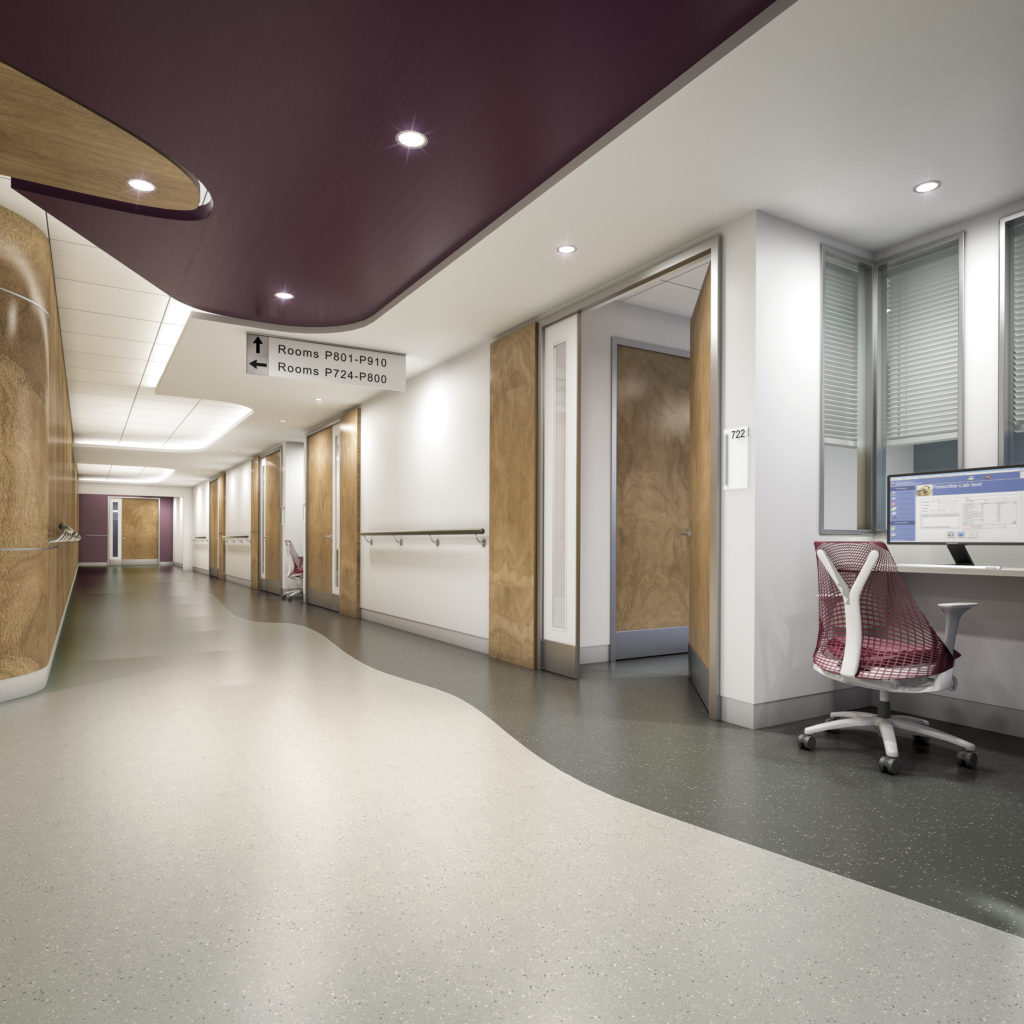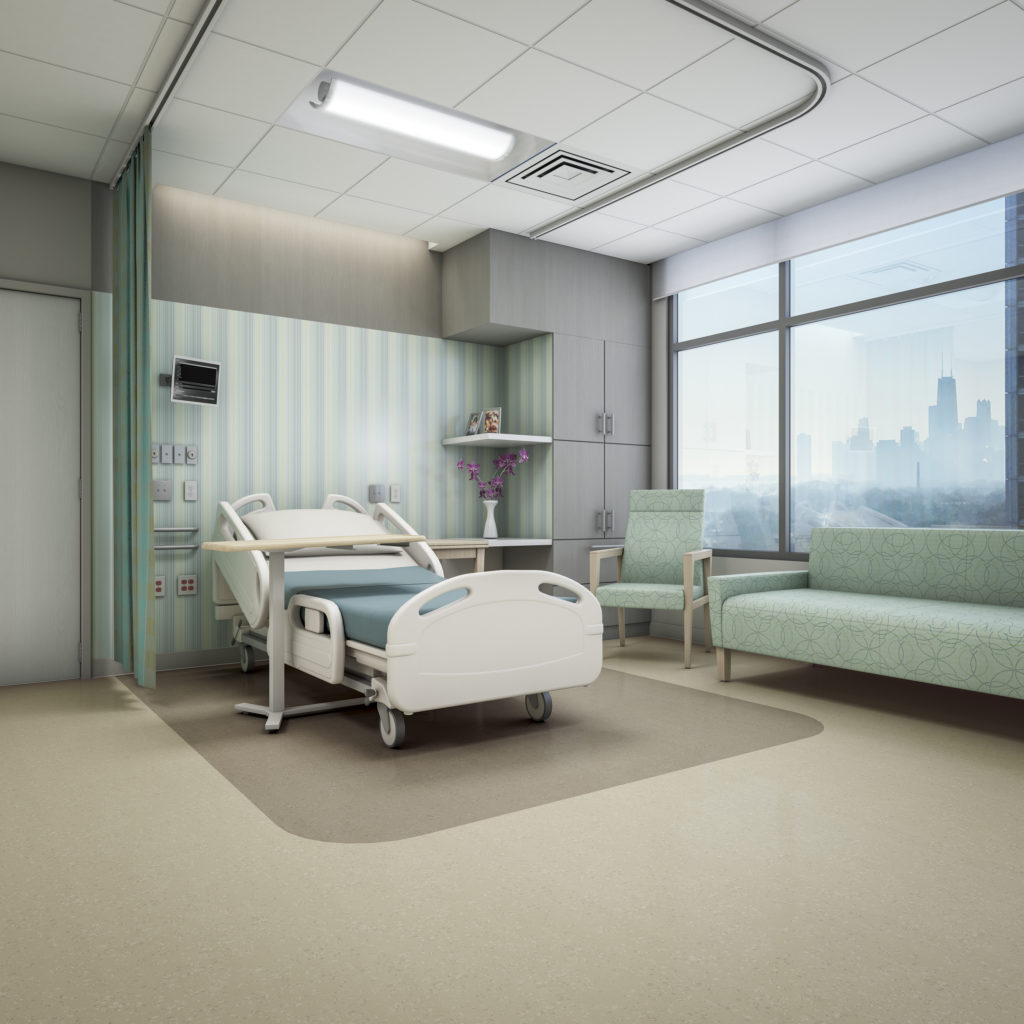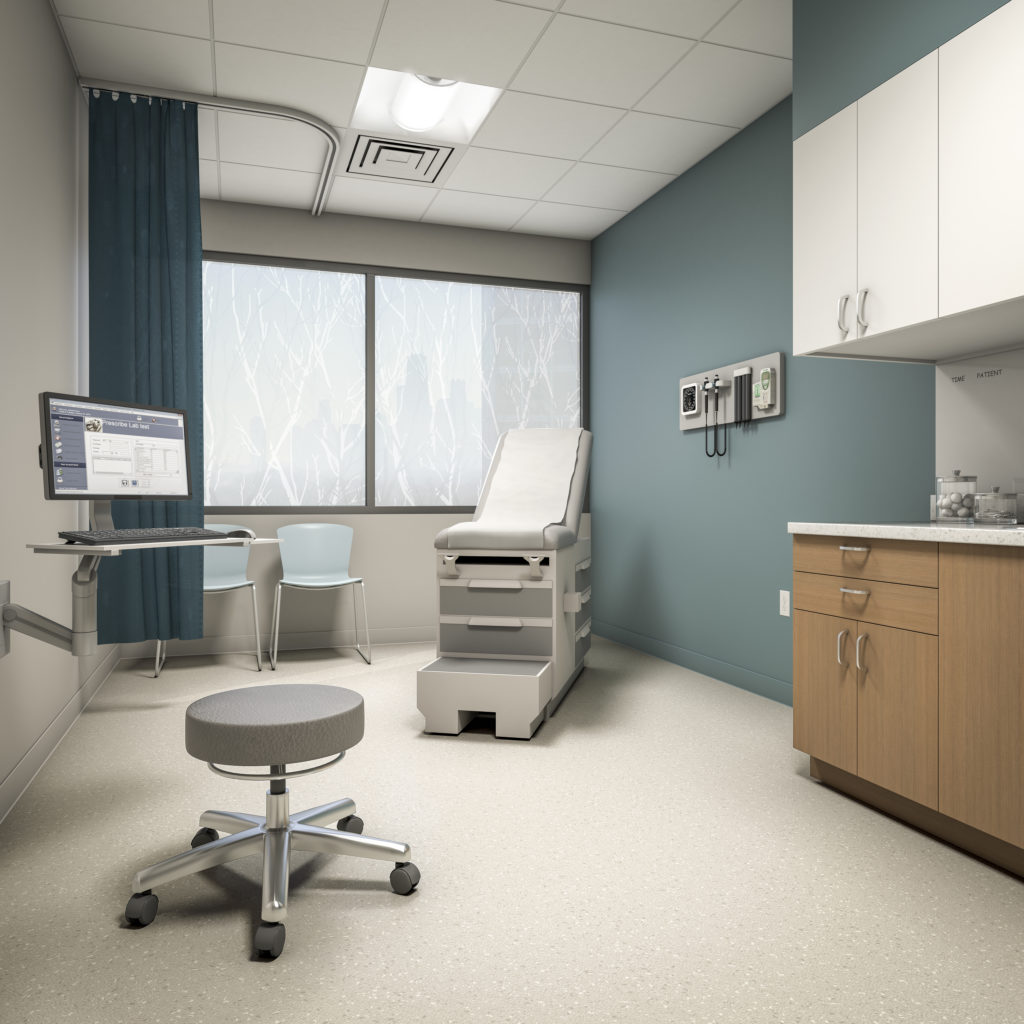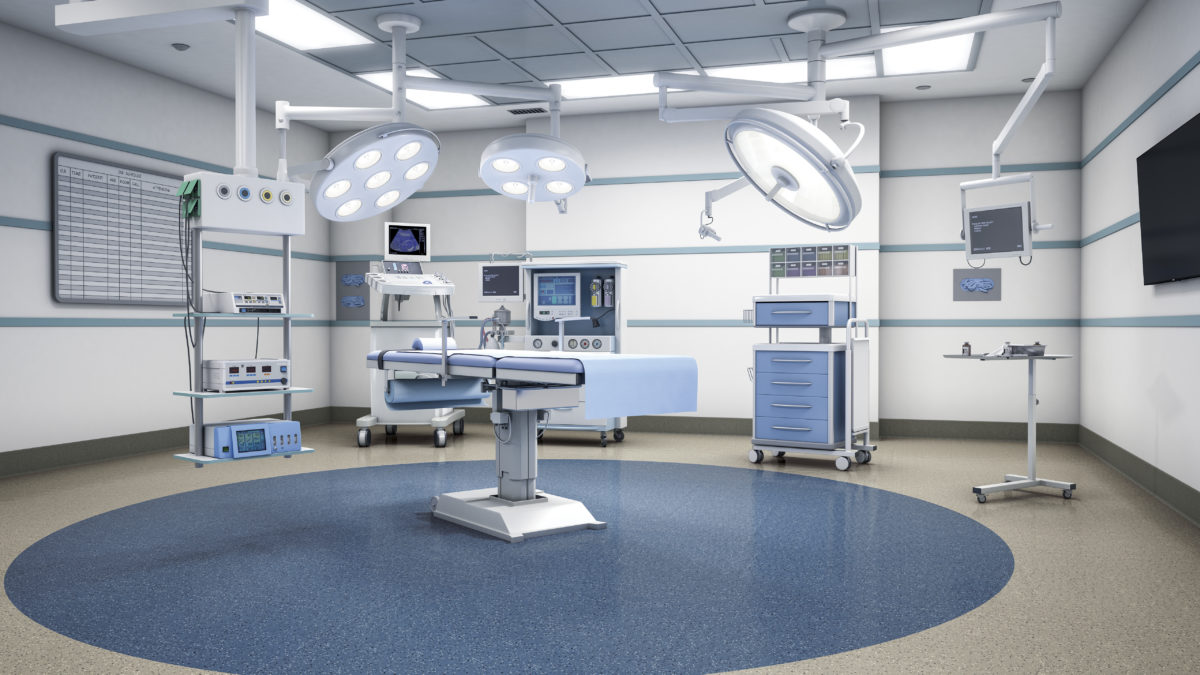
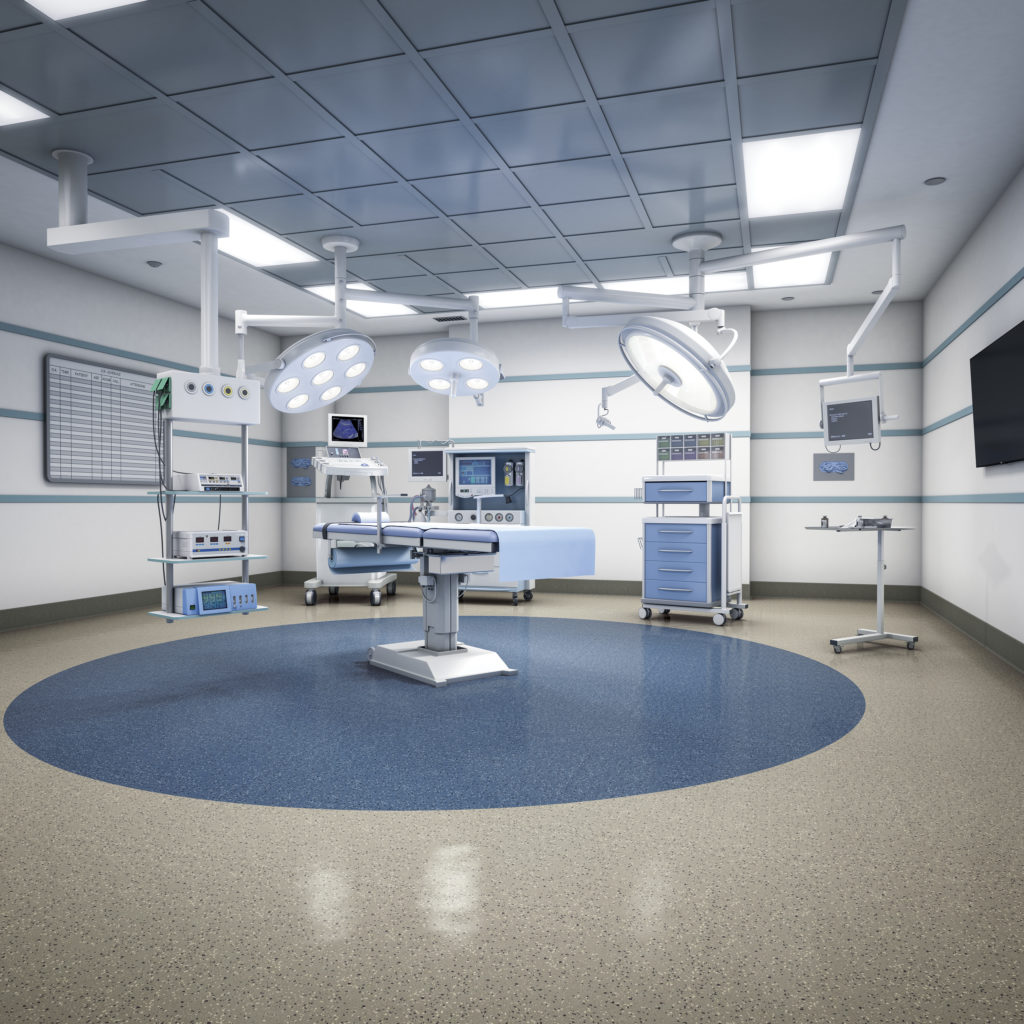
by Tasha Hughes
Safety is top-of-mind among healthcare professionals — the welfare of patients, staff and visitors is paramount. It follows, then, that safety should be just as important to those who design and construct hospitals, medical office buildings, free-standing urgent care and surgical centers, clinics and assisted living facilities. The materials they choose and install can impact safety in a variety of ways. This is especially true of interior finishes—things like furniture, fabrics, wall coverings, window treatments and floor coverings.
Among floor coverings, rubber flooring can significantly contribute to a safe environment for a variety of reasons, beginning with its composition. Rubber flooring is a sustainable material made from renewable natural rubber that is extracted from the sap of the tropical rubber tree, as well as synthetic rubber. Depending on the manufacturer, the product may also contain natural fillers to supplement the high-quality natural and industrial rubber qualities, as well as contain environmentally compatible color pigments that are free of lead and other heavy metals.
Rubber flooring promotes good indoor air quality
Just as important, many rubber floors are free of polyvinyl chloride (PVC) plastic and the risks associated with the leaching of chemicals used in the manufacturing of PVC products. Because rubber flooring does not contain PVC, it does not generate any hydrochloric acid, dioxins or furans, contributing to healthy indoor air quality for patients and staff. Nor do rubber floors contain plasticizers (phthalate) or halogens (e.g., chlorine), and some are GREENGUARD Gold Certified for low VOC emissions. This high-level certification offers stringent criteria to meet the strict emissions levels as presented by UL Environment, which focuses on healthy indoor environments.
The floor’s dense, nonporous surface makes it naturally resistant to bacteria, fungi and micro-organisms, helping to prevent infection while promoting health and safety in healthcare facilities.
Dense composition repels dirt
The floor is also easier to keep clean due to its dense, nonporous surface. The floor stays clean longer and can be maintained with regular dust mopping. When a deeper cleaning is required, a mop and tap water will often suffice, eliminating the need for harsh cleaning products. Additionally, rubber flooring does not require waxing, stripping or the application of sealants. The absence of wax and other chemicals benefits everyone in a healthcare setting, especially those who might be sensitive to smells or suffer from allergies that these products may aggravate. Patients stay in place and large areas of a facility do not need to close for an extended period of time while floors are cleaned, waxes are applied and allowed to dry. This is especially important in busy healing facilities that operate around the clock.
A dense surface also allows the floor to stand up to water, chemicals and other liquid spills without absorbing them. This includes food spills in cafeterias and break rooms, as well as disinfectants, Betadine, blood and urine, which are more common in treatment areas and patient rooms. These spills can be cleaned up quickly and effectively, leaving no residual staining and easing the cleaning process.
Slip resistance protects against falls
As these spills are removed, the likelihood of slips and falls is sharply reduced, aided by the slip-resistant properties of rubber. In many cases, the floor exceeds OSHA recommendations for slip resistance, providing the extra traction that makes for a reliable and safe surface.
Should a fall occur, the resilience of rubber flooring cushions the fall and reduces the likelihood of serious injury. This feature is most appealing for patients using canes and walkers as well as orthopedic patients working to regain their balance and ability to walk. Those in wheelchairs (and the staff who push them) also will find it easier to maneuver chairs across rubber flooring. In fact, the floor’s low resistance to wheeled equipment reduces the possibility of over-exertion on the part of the staff who move supply carts, equipment, chairs and patient beds — anything on wheels.
Comfort underfoot improves performance
The resiliency of rubber is also important to medical personnel and members of the housekeeping staff, who spend the majority of their work shifts on their feet. Hard, unforgiving flooring surfaces can cause fatigue and negatively impact performance, while softer, more cushioned rubber flooring prevents muscle fatigue and aching backs, legs, and feet. The stress of walking and standing is eased while comfort underfoot and allows nurses to concentrate on their patients.
Acoustic controls and materials that dampen ambient noise contribute to preferred heart, blood pressure and respiration rates that are essential to patient healing and reduced stress for healthcare professionals. The resilient material in rubber flooring can attenuate a significant percentage of unwanted noise. As a result, noise generated by footsteps, conversations, technology and doors closing is reduced and far less distracting. Improved acoustics encourage patient rest and sleep while healthcare workers gain concentration and retain information.
Flooring protects equipment
In areas where sensitive electronic equipment is in use, the static dissipative properties of some rubber floor coverings are also important. If electrostatic charges are not dissipated in a controlled way, they can cause failures and indication errors in measuring devices. Static dissipative flooring helps protect electrical equipment while offering the advantage of minimum charging propensity. If additional protection against electrostatic discharge is required, insulating rubber floor coverings are available, offering a resistance of more than 109 ohm.
Facilities planners and designers will be pleased with the variety of colors, patterns and textures rubber flooring offers, supporting a cohesive look that promotes a soothing, healing environment. An important wayfinding tool, rubber flooring’s texture and colors can safely guide patients and visitors through an unfamiliar facility. Simultaneously, the flooring lends itself to the use of inlays that can support a design theme with colorful logos, images and patterns or provide a way to measure progress for patients who are working on ambulating.
Safety and protection for all
Activities in healthcare environments can challenge designers and facilities planners as they search for a floor covering with properties that support the creation of a safe environment for patients, staff and visitors.
Fortunately, rubber flooring contributes to improved indoor air quality; a clean, hygienic environment; slip and stain resistance; comfort underfoot; good acoustics; and an environment that protects against electrostatic discharge. A floor covering with properties that support the creation of a safe environment for patients, staff and visitors contributes to safe spaces that foster healing and protect the health of everyone.
Tasha Hughes, Marketing Specialist for nora®. Learn more about nora® rubber flooring here.

